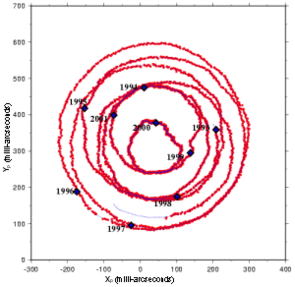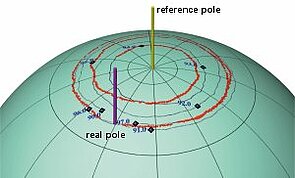Earth's shifting poles
Image of the month - December 2001


Polar motions between 1993 and 2001; a diamond marks the start of each year. Since 1993, Doris measurements (red dots) have enabled us to monitor this phenomenon with ever-increasing accuracy (the scale of variation illustrated here has been greatly exaggerated with respect to the size of the Earth: in fact, one arcmillisecond represents a shift of about three centimeters).
(Credits GRGS)
The Earth rotates in an irregular fashion due to mass shifts and variations in its rotational velocity. These variations cause its rotational axis, and therefore the poles, to "wobble". For example, observations have shown that the real position of the pole sometimes deviates up to ten meters from its theoretical position. This is the point about which the pole and the Earth's axis rotate.
The Doris orbit determination and accurate location system is used in geodesy, the science of measuring Earth's shape and motion. Besides giving us a better understanding of our planet and the ability to determine satellite orbits precisely, geodesy also allows us to locate any point on the surface of the globe with great accuracy.




